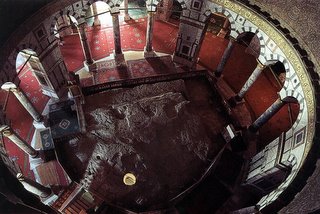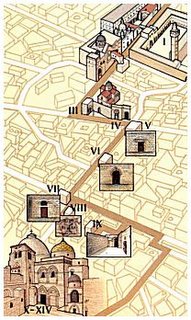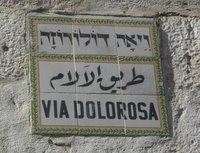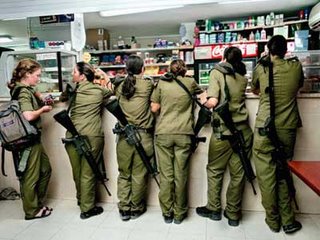 Discussing anything remotely connected to religion with students can be risky territory for a teacher to tread, but to avoid a subject for this reason has dangerous consequences. To teach a unit on conflicts in the Middle East and not include the religious significance that people have attached to specific sites within the region gives students an incomplete picture. My students come from different backgrounds - some are Christians, Jews and Muslims who have inherited their own cultural perspectives on middle eastern issues. Most don't feel any connection to the people or land involved, and seem frustrated by this lack of understanding. They hear people talk about "crisis" in the middle east and they see it constantly on the news. Without an understanding of it, I see students resigned to the assumption that people in the middle east are simply prone to fighting, that the situation is a "stupid mess". While in Jerusalem, I set out to take a tour of these sites and try a straightforward historical approach to the religious significance that people have attached to them. My goal was to make myself better prepared to answer my students' questions about "what all the fighting is about over there".
Discussing anything remotely connected to religion with students can be risky territory for a teacher to tread, but to avoid a subject for this reason has dangerous consequences. To teach a unit on conflicts in the Middle East and not include the religious significance that people have attached to specific sites within the region gives students an incomplete picture. My students come from different backgrounds - some are Christians, Jews and Muslims who have inherited their own cultural perspectives on middle eastern issues. Most don't feel any connection to the people or land involved, and seem frustrated by this lack of understanding. They hear people talk about "crisis" in the middle east and they see it constantly on the news. Without an understanding of it, I see students resigned to the assumption that people in the middle east are simply prone to fighting, that the situation is a "stupid mess". While in Jerusalem, I set out to take a tour of these sites and try a straightforward historical approach to the religious significance that people have attached to them. My goal was to make myself better prepared to answer my students' questions about "what all the fighting is about over there".The Temple Mount ר הַבַּיִת "Har haBáyit"
 The Temple Mount is an area of only thirty-five acres in the southwest corner of the old City of Jerusalem, but it is arguably the most contested real estate on earth. It has been the epicenter of the Jewish religion for almost three thousand years. According to classical Jewish belief, the temples that have been built on this site have been the primary resting place of God's presence in the physical world. Today all that remains of these temples is the mount or raised platform on which they were been built. The First Temple constructed by the Jews in the 10th century B.C.E was destroyed in 587 B.C.E by Nebuchadnezzar II of Babylon. The Second Temple was destroyed in 70 C.E By Titus of Rome. Lamenting the destruction of these temples is a central tenet of Judaism. According to Jewish scripture the mount is to be the site of the third and final temple, the rebuilding of which will signal the coming of the Messiah. Ever since the Second Temple's destruction, a prayer for the construction of the Third Temple has been a formal part of the thrice daily Jewish prayer services. Preventing Jews from carrying out the construction however, and a paramount source of contention between Jews and Muslims, is the existence of two of Islam's holiest structures that are built on top of the Temple Mount.
The Temple Mount is an area of only thirty-five acres in the southwest corner of the old City of Jerusalem, but it is arguably the most contested real estate on earth. It has been the epicenter of the Jewish religion for almost three thousand years. According to classical Jewish belief, the temples that have been built on this site have been the primary resting place of God's presence in the physical world. Today all that remains of these temples is the mount or raised platform on which they were been built. The First Temple constructed by the Jews in the 10th century B.C.E was destroyed in 587 B.C.E by Nebuchadnezzar II of Babylon. The Second Temple was destroyed in 70 C.E By Titus of Rome. Lamenting the destruction of these temples is a central tenet of Judaism. According to Jewish scripture the mount is to be the site of the third and final temple, the rebuilding of which will signal the coming of the Messiah. Ever since the Second Temple's destruction, a prayer for the construction of the Third Temple has been a formal part of the thrice daily Jewish prayer services. Preventing Jews from carrying out the construction however, and a paramount source of contention between Jews and Muslims, is the existence of two of Islam's holiest structures that are built on top of the Temple Mount.The Noble Sanctuary الحرم الشريف "Haram al-Sharif"
The same structure that is known as the Temple Mount by Jews is referred to by Muslims as "Haram al-Sharif" (The Noble Sanctuary). It is their third holiest site, proceeded in importance only by Mecca and Medina in modern Saudi Arabia. The primary reason for its significance to Muslims is the belief that Muhammad arrived here after a miraculous journey aboard the winged steed Buraq, and it was from this point that he ascended into heaven. For Muslims this is the place of Muhammad's last step in his religious journey before he met Allah and received the Islamic faith. Built on the site are two major Muslim religious shrines, "Qubbat as-Sakhra" قبة الصخرة (The Dome of the Rock) , and "Al-Aqsa Mosque" المسجد الأقصى (The Furthest Mosque).
The Dome of the Rock
 The Dome of the Rock was built in 691 C.E. by Caliph Abd al-Malik, half a century after the death of the Muslim Prophet Muhammad. It is the most visible structure in Jerusalem. It is not a mosque, but a shrine. Like the Ka'ba in Mecca, it is built over a sacred stone. This stone is believed to be the very place from which the Prophet Muhammad ascended into heaven during his Night Journey to heaven. It is the oldest Muslim building which has survived intact in its original form. It also boasts the oldest surviving mihrab (niche indicating the direction of Mecca) in the world.
The Dome of the Rock was built in 691 C.E. by Caliph Abd al-Malik, half a century after the death of the Muslim Prophet Muhammad. It is the most visible structure in Jerusalem. It is not a mosque, but a shrine. Like the Ka'ba in Mecca, it is built over a sacred stone. This stone is believed to be the very place from which the Prophet Muhammad ascended into heaven during his Night Journey to heaven. It is the oldest Muslim building which has survived intact in its original form. It also boasts the oldest surviving mihrab (niche indicating the direction of Mecca) in the world. Adding to the tension, according to Judaism this same stone is the site where Abraham fulfilled God's test to see if he would be willing to sacrifice his son Isaac (Muslims believe that this event involved Abraham's other son Ishmael and occurred in the desert of Mina where millions of Muslims offer pilgrimage every year). According to Jewish tradition, this was also the rock upon which the Ark of the Covenant was placed in the First Temple. During the existence of the Second Temple, the stone was used by High Priest who offered up incense and sprinkled the blood of sacrifices on it during the Yom Kippur Services. Rabbinic legend also alleges that the entire world was created from this stone, hence the name אבן השתייה, or Foundation Stone.
Adding to the tension, according to Judaism this same stone is the site where Abraham fulfilled God's test to see if he would be willing to sacrifice his son Isaac (Muslims believe that this event involved Abraham's other son Ishmael and occurred in the desert of Mina where millions of Muslims offer pilgrimage every year). According to Jewish tradition, this was also the rock upon which the Ark of the Covenant was placed in the First Temple. During the existence of the Second Temple, the stone was used by High Priest who offered up incense and sprinkled the blood of sacrifices on it during the Yom Kippur Services. Rabbinic legend also alleges that the entire world was created from this stone, hence the name אבן השתייה, or Foundation Stone.The Western Wall הכותל המערב "HaKotel HaMa'aravi"
 A part of the Temple Mount known as the Western wall is regarded by many as the holiest location currently accessible to Jews. It is believed to be the last remnants of the fortifications of the second temple, and it is sometimes called "The Wailing wall", in reference to Jewish mourning over the destruction of their temple. Jewish men and women can be found praying at the wall at every hour of the day and night, though a "Mechitza," or divider, separates the men's section of the wall from the women's section. It is also a tradition to deposit a slip of paper with wishes or prayers on it into the cracks of
A part of the Temple Mount known as the Western wall is regarded by many as the holiest location currently accessible to Jews. It is believed to be the last remnants of the fortifications of the second temple, and it is sometimes called "The Wailing wall", in reference to Jewish mourning over the destruction of their temple. Jewish men and women can be found praying at the wall at every hour of the day and night, though a "Mechitza," or divider, separates the men's section of the wall from the women's section. It is also a tradition to deposit a slip of paper with wishes or prayers on it into the cracks of  the wall, and looking closely, one can see hundreds of tiny, folded papers left by visitors to the wall. Bar and Bat Mitzvahs are held here, and boys and girls of age travel from all over the world to have their ceremonies held by the Western Wall.
the wall, and looking closely, one can see hundreds of tiny, folded papers left by visitors to the wall. Bar and Bat Mitzvahs are held here, and boys and girls of age travel from all over the world to have their ceremonies held by the Western Wall.The Via Dolorosa
 The Via Dolorosa (Latin for "way of grief") is traditionally believed to be the path that Jesus walked on the way to his Curcifixion. Along the path are nine of the fourteen Stations of the Cross, which each mark a site where an event occur ed in the final hours of Jesus' suffering. The last five stations are inside the Church of the Holy Sepulchre. At each site there is a small church or shrine and some kind of depiction of the event that occurred, such where Jesus collapsed, where he met his mother, where his face was wiped, and where he was stripped of his clothing. The object of the Stations is to help
The Via Dolorosa (Latin for "way of grief") is traditionally believed to be the path that Jesus walked on the way to his Curcifixion. Along the path are nine of the fourteen Stations of the Cross, which each mark a site where an event occur ed in the final hours of Jesus' suffering. The last five stations are inside the Church of the Holy Sepulchre. At each site there is a small church or shrine and some kind of depiction of the event that occurred, such where Jesus collapsed, where he met his mother, where his face was wiped, and where he was stripped of his clothing. The object of the Stations is to help  the faithful to make a spiritual pilgrimage of prayer to the chief scenes of Jesus' sufferings and death.
the faithful to make a spiritual pilgrimage of prayer to the chief scenes of Jesus' sufferings and death.The Church of the Holy Sepulcher:
 A "sepulcher" is a burial tomb, and the Holy Sepulcher derives its name from the Christian belief that it is the place where Jesus was buried and resurrected. Control of the church itself is as contested as Christianity is divided. Three major Christian denominations; Greek Orthodox, Latin and Armenian, control their own coveted turf inside and manage the church by consensus. Upkeep of the structure has been neglected due in large part to disagreements between sects over who has jurisdiction over what portions of the church. For instance, the ladder that can be seen at the window over the main entrance has been there since 1852, and has not been moved because it was present when the status quo was officially established and to do so would require the consent of each denomination. Interestingly, worries about Christian rivalries run so deep that a Palestinian Muslim family has had custody of one of the most coveted portions of the church for centuries - the keys.
A "sepulcher" is a burial tomb, and the Holy Sepulcher derives its name from the Christian belief that it is the place where Jesus was buried and resurrected. Control of the church itself is as contested as Christianity is divided. Three major Christian denominations; Greek Orthodox, Latin and Armenian, control their own coveted turf inside and manage the church by consensus. Upkeep of the structure has been neglected due in large part to disagreements between sects over who has jurisdiction over what portions of the church. For instance, the ladder that can be seen at the window over the main entrance has been there since 1852, and has not been moved because it was present when the status quo was officially established and to do so would require the consent of each denomination. Interestingly, worries about Christian rivalries run so deep that a Palestinian Muslim family has had custody of one of the most coveted portions of the church for centuries - the keys.  At the entrance to the church is the stone of Unction or of Anointing. It is a polished red stone about six meters long and one meter wide. According to tradition it was here that the body of Jesus was anointed and prepared for burial. Christian Pilgrims come from around the world to kneel and pray before the stone.
At the entrance to the church is the stone of Unction or of Anointing. It is a polished red stone about six meters long and one meter wide. According to tradition it was here that the body of Jesus was anointed and prepared for burial. Christian Pilgrims come from around the world to kneel and pray before the stone.  In the center of a large rotunda lies the empty tomb of Christ or The Edicule. It was built around the remains of the excavated cave that Jesus was believed to be set in before he was resurrected. The interior of the Edicule is lined with marble and decorated with pictures, hangings, lamps and candelabra, which are numerically divided between the different Christians sects that share its control. There is almost always a line of people waiting to enter the Edicule, and no more than four people can be admitted at one time.
In the center of a large rotunda lies the empty tomb of Christ or The Edicule. It was built around the remains of the excavated cave that Jesus was believed to be set in before he was resurrected. The interior of the Edicule is lined with marble and decorated with pictures, hangings, lamps and candelabra, which are numerically divided between the different Christians sects that share its control. There is almost always a line of people waiting to enter the Edicule, and no more than four people can be admitted at one time.----------------------------------------------------------------
The tragedy is that these sites, revered for their connection to prophets of peace, have created such a volatile element in the situation in the Middle East. After conversations with people from various sides within Jerusalem, the one thing that was clear to me, was that an offense against one of these sights had the potential to cause an immediate full-scale war throughout the region. An indication of that potential can be seen by the reaction to Arial Sharon, the former prime minister of Israel's controversial actions on September 28, 2000. Accompanied by hundreds of soldiers, he made a walking tour of the Muslim controlled Noble Sanctuary. Palestinians perceived it as a threat to their holy sites and a confirmation of their fears that Israel intended to exert control over the entire Temple Mount. Days of rioting ensued, peace talks were disrupted, and violence spiraled into a full-scale intifada. It's one of history's great ironies that Jerusalem, which translates into "city of peace", has come to be trigger so much war and bloodshed.


Evidence of the conflict over these sites is everywhere, in spray paint on the walls and in the security present around each site.

